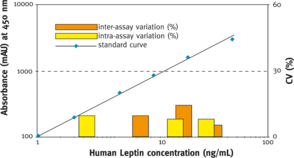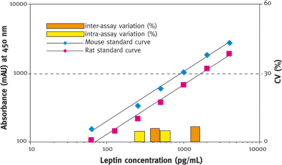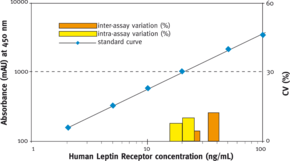Cayman
Showing 27301–27450 of 45550 results
-
Ledipasvir-d6 is intended for use as an internal standard for the quantification of ledipasvir (Item No. 18519) by GC- or LC-MS. Ledipasvir is an inhibitor of hepatitis C virus (HCV) non-structural protein 5A (NS5A).{53973,53974} It inhibits viral replication in genotype 1a and 1b HCV replicon cells (EC50s = 0.031 and 0.004 nM, respectively). It also inhibits viral replication in genotype 2a, 2b, 3a, 4a, 4d, 5a, 6a, and 6e HCV replicon cells (EC50s = 0.11-530 nM).{53974} Lepidasvir acts synergistically with IFN-α, ribavirin (Item No. 16757), or GS-9669 and additively with GS-9451, simeprevir (Item No. 22144), daclatasvir (Item No. 23730), or PSI-7977 (sofosbuvir; Item No. 15402) to inhibit viral replication in genotype 1a HCV replicon cells. Formulations containing ledipasvir have been used in combination therapy for the treatment of chronic HCV infection.
Brand:CaymanSKU:31322 - 1 mgAvailable on backorder
Ledipasvir-d6 is intended for use as an internal standard for the quantification of ledipasvir (Item No. 18519) by GC- or LC-MS. Ledipasvir is an inhibitor of hepatitis C virus (HCV) non-structural protein 5A (NS5A).{53973,53974} It inhibits viral replication in genotype 1a and 1b HCV replicon cells (EC50s = 0.031 and 0.004 nM, respectively). It also inhibits viral replication in genotype 2a, 2b, 3a, 4a, 4d, 5a, 6a, and 6e HCV replicon cells (EC50s = 0.11-530 nM).{53974} Lepidasvir acts synergistically with IFN-α, ribavirin (Item No. 16757), or GS-9669 and additively with GS-9451, simeprevir (Item No. 22144), daclatasvir (Item No. 23730), or PSI-7977 (sofosbuvir; Item No. 15402) to inhibit viral replication in genotype 1a HCV replicon cells. Formulations containing ledipasvir have been used in combination therapy for the treatment of chronic HCV infection.
Brand:CaymanSKU:31322 - 500 µgAvailable on backorder
LEE011 is a cyclin-dependent kinase (CDK) inhibitor that targets cyclin D1/CDK4 and cyclin D3/CDK6 at nanomolar concentrations.{28690,28691,28692} It inhibits retinoblastoma protein phosphorylation, which prevents CDK-mediated G1-S phase transition, arresting the cell cycle in the G1 phase, suppressing DNA synthesis, and inhibiting cancer cell growth.{28692} LEE011 has been shown to reduce proliferation in 12 of 17 human neuroblastoma-derived cell lines by inducing cytostasis (mean IC50 = 306 nM in sensitive lines).{28692}
Brand:CaymanSKU:-Available on backorder
LEE011 is a cyclin-dependent kinase (CDK) inhibitor that targets cyclin D1/CDK4 and cyclin D3/CDK6 at nanomolar concentrations.{28690,28691,28692} It inhibits retinoblastoma protein phosphorylation, which prevents CDK-mediated G1-S phase transition, arresting the cell cycle in the G1 phase, suppressing DNA synthesis, and inhibiting cancer cell growth.{28692} LEE011 has been shown to reduce proliferation in 12 of 17 human neuroblastoma-derived cell lines by inducing cytostasis (mean IC50 = 306 nM in sensitive lines).{28692}
Brand:CaymanSKU:-Available on backorder
LEE011 is a cyclin-dependent kinase (CDK) inhibitor that targets cyclin D1/CDK4 and cyclin D3/CDK6 at nanomolar concentrations.{28690,28691,28692} It inhibits retinoblastoma protein phosphorylation, which prevents CDK-mediated G1-S phase transition, arresting the cell cycle in the G1 phase, suppressing DNA synthesis, and inhibiting cancer cell growth.{28692} LEE011 has been shown to reduce proliferation in 12 of 17 human neuroblastoma-derived cell lines by inducing cytostasis (mean IC50 = 306 nM in sensitive lines).{28692}
Brand:CaymanSKU:-Available on backorder
LEE011 is a cyclin-dependent kinase (CDK) inhibitor that targets cyclin D1/CDK4 and cyclin D3/CDK6 at nanomolar concentrations.{28690,28691,28692} It inhibits retinoblastoma protein phosphorylation, which prevents CDK-mediated G1-S phase transition, arresting the cell cycle in the G1 phase, suppressing DNA synthesis, and inhibiting cancer cell growth.{28692} LEE011 has been shown to reduce proliferation in 12 of 17 human neuroblastoma-derived cell lines by inducing cytostasis (mean IC50 = 306 nM in sensitive lines).{28692}
Brand:CaymanSKU:-Available on backorder
Leelamine is a diterpene molecule whose name derives from the Sanskrit word leela which means “play”. It has weak affinity for the human central cannabinoid (CB1) and peripheral cannabinoid (CB2) receptors, exhibiting 20% displacement of [3H]-CP55940 at a concentration of 10 µM.{14127} Leelamine inhibits pyruvate dehydrogenase kinase (PDK) with an IC50 value of 9.5 µM.{14105} Derivatives of leelamine exhibit anti-inflammatory activity and show moderate inhibition of phospholipase A2 activity from a variety of sources.{14107}
Brand:CaymanSKU:10006148 - 10 mgAvailable on backorder
Leelamine is a diterpene molecule whose name derives from the Sanskrit word leela which means “play”. It has weak affinity for the human central cannabinoid (CB1) and peripheral cannabinoid (CB2) receptors, exhibiting 20% displacement of [3H]-CP55940 at a concentration of 10 µM.{14127} Leelamine inhibits pyruvate dehydrogenase kinase (PDK) with an IC50 value of 9.5 µM.{14105} Derivatives of leelamine exhibit anti-inflammatory activity and show moderate inhibition of phospholipase A2 activity from a variety of sources.{14107}
Brand:CaymanSKU:10006148 - 25 mgAvailable on backorder
Leelamine is a diterpene molecule whose name derives from the Sanskrit word leela which means “play”. It has weak affinity for the human central cannabinoid (CB1) and peripheral cannabinoid (CB2) receptors, exhibiting 20% displacement of [3H]-CP55940 at a concentration of 10 µM.{14127} Leelamine inhibits pyruvate dehydrogenase kinase (PDK) with an IC50 value of 9.5 µM.{14105} Derivatives of leelamine exhibit anti-inflammatory activity and show moderate inhibition of phospholipase A2 activity from a variety of sources.{14107}
Brand:CaymanSKU:10006148 - 5 mgAvailable on backorder
Leelamine is a diterpene molecule whose name derives from the Sanskrit word leela which means “play”. It has weak affinity for the human central cannabinoid (CB1) and peripheral cannabinoid (CB2) receptors, exhibiting 20% displacement of [3H]-CP55940 at a concentration of 10 µM.{14127} Leelamine inhibits pyruvate dehydrogenase kinase (PDK) with an IC50 value of 9.5 µM.{14105} Derivatives of leelamine exhibit anti-inflammatory activity and show moderate inhibition of phospholipase A2 activity from a variety of sources.{14107}
Brand:CaymanSKU:10006148 - 50 mgAvailable on backorder
Leelamine is a diterpene molecule whose name derives from the Sanskrit word leela which means “play”. It has weak affinity for the human central cannabinoid (CB1) and peripheral cannabinoid (CB2) receptors, exhibiting 20% displacement of [3H]-CP55940 at a concentration of 10 µM.{14127} Leelamine inhibits pyruvate dehydrogenase kinase (PDK) with an IC50 of 9.5 µM.{14105} Derivatives of leelamine exhibit anti-inflammatory activity and show moderate inhibition of phospholipase A2 activity from a variety of sources.{14107}
Brand:CaymanSKU:10008614 - 10 mgAvailable on backorder
Leelamine is a diterpene molecule whose name derives from the Sanskrit word leela which means “play”. It has weak affinity for the human central cannabinoid (CB1) and peripheral cannabinoid (CB2) receptors, exhibiting 20% displacement of [3H]-CP55940 at a concentration of 10 µM.{14127} Leelamine inhibits pyruvate dehydrogenase kinase (PDK) with an IC50 of 9.5 µM.{14105} Derivatives of leelamine exhibit anti-inflammatory activity and show moderate inhibition of phospholipase A2 activity from a variety of sources.{14107}
Brand:CaymanSKU:10008614 - 100 mgAvailable on backorder
Leelamine is a diterpene molecule whose name derives from the Sanskrit word leela which means “play”. It has weak affinity for the human central cannabinoid (CB1) and peripheral cannabinoid (CB2) receptors, exhibiting 20% displacement of [3H]-CP55940 at a concentration of 10 µM.{14127} Leelamine inhibits pyruvate dehydrogenase kinase (PDK) with an IC50 of 9.5 µM.{14105} Derivatives of leelamine exhibit anti-inflammatory activity and show moderate inhibition of phospholipase A2 activity from a variety of sources.{14107}
Brand:CaymanSKU:10008614 - 5 mgAvailable on backorder
Leelamine is a diterpene molecule whose name derives from the Sanskrit word leela which means “play”. It has weak affinity for the human central cannabinoid (CB1) and peripheral cannabinoid (CB2) receptors, exhibiting 20% displacement of [3H]-CP55940 at a concentration of 10 µM.{14127} Leelamine inhibits pyruvate dehydrogenase kinase (PDK) with an IC50 of 9.5 µM.{14105} Derivatives of leelamine exhibit anti-inflammatory activity and show moderate inhibition of phospholipase A2 activity from a variety of sources.{14107}
Brand:CaymanSKU:10008614 - 50 mgAvailable on backorder
Leflunomide is a synthetic isoxazol and a prodrug form of A-771726 (Item No. 14404), a dihydroorotate dehydrogenase inhibitor.{22723} Leflunomide inhibits de novo pyrimidine synthesis to regulate T lymphocyte progression through the cell cycle. It inhibits proliferation and activation of T cells when used at concentrations of 25 and 100 µM, respectively, for naïve and memory CD4+ T cells.{46073} It also reduces the production of Th1 effector cells and increases differentiation of Th2 cells in vitro and in splenocytes isolated from KLH-immunized mice. Leflunomide (35 mg/kg per day) reduces and prevents inflammation in a proteoglycan-induced mouse model of rheumatoid arthritis.{46074} Formulations containing leflunomide have been used in the treatment of active rheumatoid arthritis.
Brand:CaymanSKU:-Leflunomide is a synthetic isoxazol and a prodrug form of A-771726 (Item No. 14404), a dihydroorotate dehydrogenase inhibitor.{22723} Leflunomide inhibits de novo pyrimidine synthesis to regulate T lymphocyte progression through the cell cycle. It inhibits proliferation and activation of T cells when used at concentrations of 25 and 100 µM, respectively, for naïve and memory CD4+ T cells.{46073} It also reduces the production of Th1 effector cells and increases differentiation of Th2 cells in vitro and in splenocytes isolated from KLH-immunized mice. Leflunomide (35 mg/kg per day) reduces and prevents inflammation in a proteoglycan-induced mouse model of rheumatoid arthritis.{46074} Formulations containing leflunomide have been used in the treatment of active rheumatoid arthritis.
Brand:CaymanSKU:-Leflunomide is a synthetic isoxazol and a prodrug form of A-771726 (Item No. 14404), a dihydroorotate dehydrogenase inhibitor.{22723} Leflunomide inhibits de novo pyrimidine synthesis to regulate T lymphocyte progression through the cell cycle. It inhibits proliferation and activation of T cells when used at concentrations of 25 and 100 µM, respectively, for naïve and memory CD4+ T cells.{46073} It also reduces the production of Th1 effector cells and increases differentiation of Th2 cells in vitro and in splenocytes isolated from KLH-immunized mice. Leflunomide (35 mg/kg per day) reduces and prevents inflammation in a proteoglycan-induced mouse model of rheumatoid arthritis.{46074} Formulations containing leflunomide have been used in the treatment of active rheumatoid arthritis.
Brand:CaymanSKU:-Leflunomide is a synthetic isoxazol and a prodrug form of A-771726 (Item No. 14404), a dihydroorotate dehydrogenase inhibitor.{22723} Leflunomide inhibits de novo pyrimidine synthesis to regulate T lymphocyte progression through the cell cycle. It inhibits proliferation and activation of T cells when used at concentrations of 25 and 100 µM, respectively, for naïve and memory CD4+ T cells.{46073} It also reduces the production of Th1 effector cells and increases differentiation of Th2 cells in vitro and in splenocytes isolated from KLH-immunized mice. Leflunomide (35 mg/kg per day) reduces and prevents inflammation in a proteoglycan-induced mouse model of rheumatoid arthritis.{46074} Formulations containing leflunomide have been used in the treatment of active rheumatoid arthritis.
Brand:CaymanSKU:-Leflunomide-d4 is intended for use as an internal standard for the quantification of leflunomide (Item No. 14860) by GC- or LC-MS. Leflunomide is a synthetic isoxazol and a prodrug form of A-771726 (Item No. 14404), a dihydroorotate dehydrogenase inhibitor.{22723} Leflunomide inhibits de novo pyrimidine synthesis to regulate T lymphocyte progression through the cell cycle. It inhibits proliferation and activation of T cells when used at concentrations of 25 and 100 µM, respectively, for naïve and memory CD4+ T cells.{46073} It also reduces the production of Th1 effector cells and increases differentiation of Th2 cells in vitro and in splenocytes isolated from KLH-immunized mice. Leflunomide (35 mg/kg per day) reduces and prevents inflammation in a proteoglycan-induced mouse model of rheumatoid arthritis.{46074} Formulations containing leflunomide have been used in the treatment of active rheumatoid arthritis.
Brand:CaymanSKU:26448 - 1 mgAvailable on backorder
Leflunomide-d4 is intended for use as an internal standard for the quantification of leflunomide (Item No. 14860) by GC- or LC-MS. Leflunomide is a synthetic isoxazol and a prodrug form of A-771726 (Item No. 14404), a dihydroorotate dehydrogenase inhibitor.{22723} Leflunomide inhibits de novo pyrimidine synthesis to regulate T lymphocyte progression through the cell cycle. It inhibits proliferation and activation of T cells when used at concentrations of 25 and 100 µM, respectively, for naïve and memory CD4+ T cells.{46073} It also reduces the production of Th1 effector cells and increases differentiation of Th2 cells in vitro and in splenocytes isolated from KLH-immunized mice. Leflunomide (35 mg/kg per day) reduces and prevents inflammation in a proteoglycan-induced mouse model of rheumatoid arthritis.{46074} Formulations containing leflunomide have been used in the treatment of active rheumatoid arthritis.
Brand:CaymanSKU:26448 - 500 µgAvailable on backorder
In humans, two forms of diacylglycerol lipase, DAGLα and DAGLβ, generate the endocannabinoid 2-arachidonoyl glycerol (2-AG; Item No. 62160) by attacking DAG at the sn-1 position. LEI-106 is a potent in vitro inhibitor of sn-1 DAGLα (IC50 = 18 nM).{26613} It blocks the hydrolysis of sn-1-oleoyl-2-AG, the natural substrate of DAGLα, with a Ki value of 0.7 µM.{26613} LEI-106 inhibits the hydrolysis of 2-AG by the monoacylglycerol lipase ABHD6 in mouse brain membrane homogenates and in HEK293T cell membrane preparations (Ki = 0.8 µM).{26613}
Brand:CaymanSKU:-Out of stock
In humans, two forms of diacylglycerol lipase, DAGLα and DAGLβ, generate the endocannabinoid 2-arachidonoyl glycerol (2-AG; Item No. 62160) by attacking DAG at the sn-1 position. LEI-106 is a potent in vitro inhibitor of sn-1 DAGLα (IC50 = 18 nM).{26613} It blocks the hydrolysis of sn-1-oleoyl-2-AG, the natural substrate of DAGLα, with a Ki value of 0.7 µM.{26613} LEI-106 inhibits the hydrolysis of 2-AG by the monoacylglycerol lipase ABHD6 in mouse brain membrane homogenates and in HEK293T cell membrane preparations (Ki = 0.8 µM).{26613}
Brand:CaymanSKU:-Out of stock
In humans, two forms of diacylglycerol lipase, DAGLα and DAGLβ, generate the endocannabinoid 2-arachidonoyl glycerol (2-AG; Item No. 62160) by attacking DAG at the sn-1 position. LEI-106 is a potent in vitro inhibitor of sn-1 DAGLα (IC50 = 18 nM).{26613} It blocks the hydrolysis of sn-1-oleoyl-2-AG, the natural substrate of DAGLα, with a Ki value of 0.7 µM.{26613} LEI-106 inhibits the hydrolysis of 2-AG by the monoacylglycerol lipase ABHD6 in mouse brain membrane homogenates and in HEK293T cell membrane preparations (Ki = 0.8 µM).{26613}
Brand:CaymanSKU:-Out of stock
In humans, two forms of diacylglycerol lipase, DAGLα and DAGLβ, generate the endocannabinoid 2-arachidonoyl glycerol (2-AG; Item No. 62160) by attacking DAG at the sn-1 position. LEI-106 is a potent in vitro inhibitor of sn-1 DAGLα (IC50 = 18 nM).{26613} It blocks the hydrolysis of sn-1-oleoyl-2-AG, the natural substrate of DAGLα, with a Ki value of 0.7 µM.{26613} LEI-106 inhibits the hydrolysis of 2-AG by the monoacylglycerol lipase ABHD6 in mouse brain membrane homogenates and in HEK293T cell membrane preparations (Ki = 0.8 µM).{26613}
Brand:CaymanSKU:-Out of stock
Lenalidomide is an analog of thalidomide (Item No. 14610) that, at 10 μM, alters gene expression and cell viability in a range of cancer cell lines.{23400} It also induces proliferation and enhances the functional capacity of T-lymphocytes, amplifying co-stimulatory signaling pathways.{23399} Lenalidomide is effective in hematologic cancers, including lymphomas and myelomas.{23398,23397}
Brand:CaymanSKU:-Lenalidomide is an analog of thalidomide (Item No. 14610) that, at 10 μM, alters gene expression and cell viability in a range of cancer cell lines.{23400} It also induces proliferation and enhances the functional capacity of T-lymphocytes, amplifying co-stimulatory signaling pathways.{23399} Lenalidomide is effective in hematologic cancers, including lymphomas and myelomas.{23398,23397}
Brand:CaymanSKU:-Lenalidomide is an analog of thalidomide (Item No. 14610) that, at 10 μM, alters gene expression and cell viability in a range of cancer cell lines.{23400} It also induces proliferation and enhances the functional capacity of T-lymphocytes, amplifying co-stimulatory signaling pathways.{23399} Lenalidomide is effective in hematologic cancers, including lymphomas and myelomas.{23398,23397}
Brand:CaymanSKU:-Lenalidomide-d5 is intended for use as an internal standard for the quantification of lenalidomide (Item No. 14643) by GC- or LC-MS. Lenalidomide is related to thalidomide (Item No. 14610) and, at 10 μM, alters gene expression and cell viability in a range of cancer cell lines.{23400} It also induces proliferation and enhances the functional capacity of T lymphocytes, amplifying co-stimulatory signaling pathways.{23399} Lenalidomide is effective in hematologic cancers, including lymphomas and myelomas.{23398,23397}
Brand:CaymanSKU:22370 -Out of stock
Lenalidomide-d5 is intended for use as an internal standard for the quantification of lenalidomide (Item No. 14643) by GC- or LC-MS. Lenalidomide is related to thalidomide (Item No. 14610) and, at 10 μM, alters gene expression and cell viability in a range of cancer cell lines.{23400} It also induces proliferation and enhances the functional capacity of T lymphocytes, amplifying co-stimulatory signaling pathways.{23399} Lenalidomide is effective in hematologic cancers, including lymphomas and myelomas.{23398,23397}
Brand:CaymanSKU:22370 -Out of stock
Leniolisib is an inhibitor of PI3Kδ (IC50 = 0.011 µM).{40219} It is selective for PI3Kδ over PI3Kα, PI3Kβ, and PI3Kγ (IC50s = 0.244, 0.424, and 2.23 µM, respectively). It inhibits phosphorylation of the PI3K target Akt in Rat-1 fibroblasts expressing P13K p110δ with an IC50 value of 0.056 µM. Leniolisib inhibits the mixed lymphocyte reaction (MLR), indicating inhibition of allogeneic T cell activation, in isolated human peripheral blood mononuclear cells (PBMCs) and isolated mouse splenocytes (IC50s = 0.079 and 0.033 µM, respectively). It also inhibits PI3Kδ-dependent B cell activation and IgM-induced B cell proliferation in isolated mouse splenocytes. Leniolisib (3 and 10 mg/kg) reduces the production of rat anti-rat collagen antibodies, as well as reduces paw swelling and joint erosion in a rat model of collagen-induced arthritis.
Brand:CaymanSKU:28078 - 1 mgAvailable on backorder
Leniolisib is an inhibitor of PI3Kδ (IC50 = 0.011 µM).{40219} It is selective for PI3Kδ over PI3Kα, PI3Kβ, and PI3Kγ (IC50s = 0.244, 0.424, and 2.23 µM, respectively). It inhibits phosphorylation of the PI3K target Akt in Rat-1 fibroblasts expressing P13K p110δ with an IC50 value of 0.056 µM. Leniolisib inhibits the mixed lymphocyte reaction (MLR), indicating inhibition of allogeneic T cell activation, in isolated human peripheral blood mononuclear cells (PBMCs) and isolated mouse splenocytes (IC50s = 0.079 and 0.033 µM, respectively). It also inhibits PI3Kδ-dependent B cell activation and IgM-induced B cell proliferation in isolated mouse splenocytes. Leniolisib (3 and 10 mg/kg) reduces the production of rat anti-rat collagen antibodies, as well as reduces paw swelling and joint erosion in a rat model of collagen-induced arthritis.
Brand:CaymanSKU:28078 - 10 mgAvailable on backorder
Leniolisib is an inhibitor of PI3Kδ (IC50 = 0.011 µM).{40219} It is selective for PI3Kδ over PI3Kα, PI3Kβ, and PI3Kγ (IC50s = 0.244, 0.424, and 2.23 µM, respectively). It inhibits phosphorylation of the PI3K target Akt in Rat-1 fibroblasts expressing P13K p110δ with an IC50 value of 0.056 µM. Leniolisib inhibits the mixed lymphocyte reaction (MLR), indicating inhibition of allogeneic T cell activation, in isolated human peripheral blood mononuclear cells (PBMCs) and isolated mouse splenocytes (IC50s = 0.079 and 0.033 µM, respectively). It also inhibits PI3Kδ-dependent B cell activation and IgM-induced B cell proliferation in isolated mouse splenocytes. Leniolisib (3 and 10 mg/kg) reduces the production of rat anti-rat collagen antibodies, as well as reduces paw swelling and joint erosion in a rat model of collagen-induced arthritis.
Brand:CaymanSKU:28078 - 25 mgAvailable on backorder
Leniolisib is an inhibitor of PI3Kδ (IC50 = 0.011 µM).{40219} It is selective for PI3Kδ over PI3Kα, PI3Kβ, and PI3Kγ (IC50s = 0.244, 0.424, and 2.23 µM, respectively). It inhibits phosphorylation of the PI3K target Akt in Rat-1 fibroblasts expressing P13K p110δ with an IC50 value of 0.056 µM. Leniolisib inhibits the mixed lymphocyte reaction (MLR), indicating inhibition of allogeneic T cell activation, in isolated human peripheral blood mononuclear cells (PBMCs) and isolated mouse splenocytes (IC50s = 0.079 and 0.033 µM, respectively). It also inhibits PI3Kδ-dependent B cell activation and IgM-induced B cell proliferation in isolated mouse splenocytes. Leniolisib (3 and 10 mg/kg) reduces the production of rat anti-rat collagen antibodies, as well as reduces paw swelling and joint erosion in a rat model of collagen-induced arthritis.
Brand:CaymanSKU:28078 - 5 mgAvailable on backorder
Lenvatinib is an inhibitor of the receptor tyrosine kinases VEGF receptor 2 (VEGFR2) and VEGFR3 (IC50s = 4 and 5.2 nM, respectively).{32663,32664} It also inhibits the related kinases VEGFR1, FGFR1, PDGFRα, PDGFRβ and Kit (IC50s = 22, 46, 51, 39, and 100 nM, respectively).{32663} Lenvatinib (30 mg/kg, twice per day) reduces tumor growth in an H146 small cell lung cancer mouse xenograft model and induces tumor regression when administered at a dose of 100 mg/kg twice per day. Formulations containing lenvatinib have been used in the treatment of differentiated thyroid cancer, renal cell carcinoma, and hepatocellular carcinoma.
Brand:CaymanSKU:-Available on backorder
Lenvatinib is an inhibitor of the receptor tyrosine kinases VEGF receptor 2 (VEGFR2) and VEGFR3 (IC50s = 4 and 5.2 nM, respectively).{32663,32664} It also inhibits the related kinases VEGFR1, FGFR1, PDGFRα, PDGFRβ and Kit (IC50s = 22, 46, 51, 39, and 100 nM, respectively).{32663} Lenvatinib (30 mg/kg, twice per day) reduces tumor growth in an H146 small cell lung cancer mouse xenograft model and induces tumor regression when administered at a dose of 100 mg/kg twice per day. Formulations containing lenvatinib have been used in the treatment of differentiated thyroid cancer, renal cell carcinoma, and hepatocellular carcinoma.
Brand:CaymanSKU:-Available on backorder
Lenvatinib is an inhibitor of the receptor tyrosine kinases VEGF receptor 2 (VEGFR2) and VEGFR3 (IC50s = 4 and 5.2 nM, respectively).{32663,32664} It also inhibits the related kinases VEGFR1, FGFR1, PDGFRα, PDGFRβ and Kit (IC50s = 22, 46, 51, 39, and 100 nM, respectively).{32663} Lenvatinib (30 mg/kg, twice per day) reduces tumor growth in an H146 small cell lung cancer mouse xenograft model and induces tumor regression when administered at a dose of 100 mg/kg twice per day. Formulations containing lenvatinib have been used in the treatment of differentiated thyroid cancer, renal cell carcinoma, and hepatocellular carcinoma.
Brand:CaymanSKU:-Available on backorder
Lenvatinib is an inhibitor of the receptor tyrosine kinases VEGF receptor 2 (VEGFR2) and VEGFR3 (IC50s = 4 and 5.2 nM, respectively).{32663,32664} It also inhibits the related kinases VEGFR1, FGFR1, PDGFRα, PDGFRβ and Kit (IC50s = 22, 46, 51, 39, and 100 nM, respectively).{32663} Lenvatinib (30 mg/kg, twice per day) reduces tumor growth in an H146 small cell lung cancer mouse xenograft model and induces tumor regression when administered at a dose of 100 mg/kg twice per day. Formulations containing lenvatinib have been used in the treatment of differentiated thyroid cancer, renal cell carcinoma, and hepatocellular carcinoma.
Brand:CaymanSKU:-Available on backorder
Lenvatinib is an inhibitor of the receptor tyrosine kinases VEGF receptor 2 (VEGFR2) and VEGFR3 (IC50s = 4 and 5.2 nM, respectively).{32663,32664} It also inhibits the related kinases VEGFR1, FGFR1, PDGFRα, PDGFRβ and KIT (IC50s = 22, 46, 51, 39, and 100 nM, respectively).{32663} Lenvatinib (30 mg/kg, twice per day) reduces tumor growth in an H146 small cell lung cancer mouse xenograft model and induces tumor regression when administered at a dose of 100 mg/kg twice per day. Formulations containing lenvatinib have been used in the treatment of differentiated thyroid cancer, renal cell carcinoma, and hepatocellular carcinoma.
Brand:CaymanSKU:29832 - 1 gAvailable on backorder
Lenvatinib is an inhibitor of the receptor tyrosine kinases VEGF receptor 2 (VEGFR2) and VEGFR3 (IC50s = 4 and 5.2 nM, respectively).{32663,32664} It also inhibits the related kinases VEGFR1, FGFR1, PDGFRα, PDGFRβ and KIT (IC50s = 22, 46, 51, 39, and 100 nM, respectively).{32663} Lenvatinib (30 mg/kg, twice per day) reduces tumor growth in an H146 small cell lung cancer mouse xenograft model and induces tumor regression when administered at a dose of 100 mg/kg twice per day. Formulations containing lenvatinib have been used in the treatment of differentiated thyroid cancer, renal cell carcinoma, and hepatocellular carcinoma.
Brand:CaymanSKU:29832 - 5 gAvailable on backorder
Lenvatinib is an inhibitor of the receptor tyrosine kinases VEGF receptor 2 (VEGFR2) and VEGFR3 (IC50s = 4 and 5.2 nM, respectively).{32663,32664} It also inhibits the related kinases VEGFR1, FGFR1, PDGFRα, PDGFRβ and KIT (IC50s = 22, 46, 51, 39, and 100 nM, respectively).{32663} Lenvatinib (30 mg/kg, twice per day) reduces tumor growth in an H146 small cell lung cancer mouse xenograft model and induces tumor regression when administered at a dose of 100 mg/kg twice per day. Formulations containing lenvatinib have been used in the treatment of differentiated thyroid cancer, renal cell carcinoma, and hepatocellular carcinoma.
Brand:CaymanSKU:29832 - 500 mgAvailable on backorder
Leoidin is a depsidone originally isolated from L. gangaleoides that has antibacterial and enzyme inhibitory activities.{52316,52317,48817} It is active against the bacteria E. faecalis, H. influenzae, M. catarrhalis, S. aureus, and S. pneumoniae (MICs = 8, 32, 1, 128, and 64 µg/ml, respectively).{52317} Leoidin inhibits phenylalanyl-tRNA synthetase (PheRS) isolated from P. aeruginosa (IC50 = 42 µM). It also inhibits organic anion-transporting polypeptide 1B1 (OATP1B1) and OATP1B3 with Ki values of 0.08 and 1.84 µM, respectively, in CHO cells expressing the human transporters.{48817}
Brand:CaymanSKU:29939 - 1 mgAvailable on backorder
Leoidin is a depsidone originally isolated from L. gangaleoides that has antibacterial and enzyme inhibitory activities.{52316,52317,48817} It is active against the bacteria E. faecalis, H. influenzae, M. catarrhalis, S. aureus, and S. pneumoniae (MICs = 8, 32, 1, 128, and 64 µg/ml, respectively).{52317} Leoidin inhibits phenylalanyl-tRNA synthetase (PheRS) isolated from P. aeruginosa (IC50 = 42 µM). It also inhibits organic anion-transporting polypeptide 1B1 (OATP1B1) and OATP1B3 with Ki values of 0.08 and 1.84 µM, respectively, in CHO cells expressing the human transporters.{48817}
Brand:CaymanSKU:29939 - 5 mgAvailable on backorder
Leonurine is an alkaloid that has been found in H. leonuri and has diverse biological activities.{43891,43892,43893,43894} It reduces infarct size and collagen deposition and inhibits apoptosis of cardiomyocytes in a coronary artery ligation-induced rat model of myocardial infarction when administered at a dose of 15 mg/kg per day.{43892} Leonurine (200 mg/kg per day) increases hepatic levels of superoxide dismutase (SOD) and glutathione (GSH), reduces serum alanine aminotransferase (ALT) and aspartate aminotransferase (AST) levels, and inhibits hepatic fibrosis in a diet-induced mouse model of non-alcoholic steatohepatitis (NASH).{43893} It inhibits LPS-induced increases in TNF-α, IL-1β, and IL-6 levels in the serum of broiler chicks when administered at a dose of 120 mg/kg.{43894}
Brand:CaymanSKU:26850 - 10 mgAvailable on backorder
Leonurine is an alkaloid that has been found in H. leonuri and has diverse biological activities.{43891,43892,43893,43894} It reduces infarct size and collagen deposition and inhibits apoptosis of cardiomyocytes in a coronary artery ligation-induced rat model of myocardial infarction when administered at a dose of 15 mg/kg per day.{43892} Leonurine (200 mg/kg per day) increases hepatic levels of superoxide dismutase (SOD) and glutathione (GSH), reduces serum alanine aminotransferase (ALT) and aspartate aminotransferase (AST) levels, and inhibits hepatic fibrosis in a diet-induced mouse model of non-alcoholic steatohepatitis (NASH).{43893} It inhibits LPS-induced increases in TNF-α, IL-1β, and IL-6 levels in the serum of broiler chicks when administered at a dose of 120 mg/kg.{43894}
Brand:CaymanSKU:26850 - 100 mgAvailable on backorder
Leonurine is an alkaloid that has been found in H. leonuri and has diverse biological activities.{43891,43892,43893,43894} It reduces infarct size and collagen deposition and inhibits apoptosis of cardiomyocytes in a coronary artery ligation-induced rat model of myocardial infarction when administered at a dose of 15 mg/kg per day.{43892} Leonurine (200 mg/kg per day) increases hepatic levels of superoxide dismutase (SOD) and glutathione (GSH), reduces serum alanine aminotransferase (ALT) and aspartate aminotransferase (AST) levels, and inhibits hepatic fibrosis in a diet-induced mouse model of non-alcoholic steatohepatitis (NASH).{43893} It inhibits LPS-induced increases in TNF-α, IL-1β, and IL-6 levels in the serum of broiler chicks when administered at a dose of 120 mg/kg.{43894}
Brand:CaymanSKU:26850 - 250 mgAvailable on backorder
Leonurine is an alkaloid that has been found in H. leonuri and has diverse biological activities.{43891,43892,43893,43894} It reduces infarct size and collagen deposition and inhibits apoptosis of cardiomyocytes in a coronary artery ligation-induced rat model of myocardial infarction when administered at a dose of 15 mg/kg per day.{43892} Leonurine (200 mg/kg per day) increases hepatic levels of superoxide dismutase (SOD) and glutathione (GSH), reduces serum alanine aminotransferase (ALT) and aspartate aminotransferase (AST) levels, and inhibits hepatic fibrosis in a diet-induced mouse model of non-alcoholic steatohepatitis (NASH).{43893} It inhibits LPS-induced increases in TNF-α, IL-1β, and IL-6 levels in the serum of broiler chicks when administered at a dose of 120 mg/kg.{43894}
Brand:CaymanSKU:26850 - 50 mgAvailable on backorder
Lepimectin A4 is a synthetic macrocyclic lactone and a component of the insecticide lepimectin.{52308}
Brand:CaymanSKU:30072 - 5 mgAvailable on backorder
Lepimectin A4 is a synthetic macrocyclic lactone and a component of the insecticide lepimectin.{52308}
Brand:CaymanSKU:30072 - 500 µgAvailable on backorder
Leptin, the product of the ob (obese) gene, is produced mainly in the adipose tissue, and is considered to play an important role in appetite control, fat metabolism, and body weight regulation. The primary effect of leptin appears to be mediated by leptin receptors expressed mainly in the hypothalamus. In humans, leptin levels correlate with body mass index (BMI) and percentage body fat, and are elevated even in obese individuals. Leptin has a dual action; it decreases the appetite and increases energy consumption. Leptin is secreted in circadian fashion with nocturnal rise in both lean and obese patients. Mutations of the ob gene resulting in leptin deficiency are the cause of obesity in the ob/ob mice suggesting that endogeneous leptin can normalize their body weight. In contrast, human obese subjects may have high level of leptin, indicating a mechanism of leptin resistance. This Enzyme Immunometric Assay (EIA) is based on a double-antibody sandwich technique. The wells of the plate supplied with the kit are coated with a polyclonal antibody specific of human leptin. This antibody will bind any Leptin introduced in the wells (sample or standard). [Bertin Catalog No. A05174]
Brand:CaymanSKU:500010 - 96 wellsAvailable on backorder
Leptin is a 16 kDa protein hormone encoded by the obese (ob) gene with important effects in metabolism and regulating body weight. Leptin has dual actions, decreasing appetite and increasing energy consumption. Mutations in the ob gene or leptin receptor gene causes hyperphagia, reduced energy expenditure, and severe obesity. Studies have also shown that leptin is a regulator of reproductive function, bone metabolism and plays a significant role as an immunomodulator. This Enzyme Immunometric Assay (EIA) is based on a double-antibody sandwich technique specific for mouse and rat leptin. [Bertin Catalog No. A05176]
Brand:CaymanSKU:10007609 - 96 wellsAvailable on backorder
Leptin, the product of the ob (obese) gene, is produced mainly in adipose tissue and is considered to play an important role in appetite control, fat metabolism and body weight regulation. The primary effect of leptin appears to be mediated by leptin receptors expressed mainly in the hypothalamus. This Enzyme Immunometric Assay (EIA) is based on a double-antibody sandwich technique specific for the human leptin receptor. The assay utilizes plates coated with a polyclonal antibody specific for the human leptin receptor and a HRP-conjugated polyclonal antibody for detection. [Bertin Catalog No. A05175]
Brand:CaymanSKU:10007608 - 96 wellsAvailable on backorder
Leptomycin A is an inhibitor of CRM1 (exportin 1) that blocks CRM1 interaction with nuclear export signals, preventing the nuclear export of a broad range of proteins.{15319} Leptomycin A inhibits Rev translocation, though less potently than leptomycin B (Item No. 10004976) with IC50 values of 0.8 and 0.1 nM, respectively after 7 hours.{31689} Rev export to the cytoplasm is required for HIV-1 replication. Leptomycin A was originally identified as an antifungal agent.
Brand:CaymanSKU:21762 -Out of stock
Leptomycin A is an inhibitor of CRM1 (exportin 1) that blocks CRM1 interaction with nuclear export signals, preventing the nuclear export of a broad range of proteins.{15319} Leptomycin A inhibits Rev translocation, though less potently than leptomycin B (Item No. 10004976) with IC50 values of 0.8 and 0.1 nM, respectively after 7 hours.{31689} Rev export to the cytoplasm is required for HIV-1 replication. Leptomycin A was originally identified as an antifungal agent.
Brand:CaymanSKU:21762 -Out of stock
Leptomycin B is a potent inhibitor of the nuclear export of proteins. It directly blocks the interaction of CRM1 (exportin 1) with nuclear export signals (NES), preventing the export of a broad range of proteins.{15319} Leptomycin B will also indirectly inhibit the export of mRNA from the nucleus by blocking the nuclear export of mRNA-binding proteins (export factors).{15320} By blocking the nuclear export of p53, leptomycin B prevents entry of human normal fibroblasts into the S phase of the cell cycle, thus inhibiting proliferation.{15382} Leptomycin B was originally identified as an antifungal agent and is isolated from Streptomyces sp..
Brand:CaymanSKU:10004976 - 10 µgAvailable on backorder
Leptomycin B is a potent inhibitor of the nuclear export of proteins. It directly blocks the interaction of CRM1 (exportin 1) with nuclear export signals (NES), preventing the export of a broad range of proteins.{15319} Leptomycin B will also indirectly inhibit the export of mRNA from the nucleus by blocking the nuclear export of mRNA-binding proteins (export factors).{15320} By blocking the nuclear export of p53, leptomycin B prevents entry of human normal fibroblasts into the S phase of the cell cycle, thus inhibiting proliferation.{15382} Leptomycin B was originally identified as an antifungal agent and is isolated from Streptomyces sp..
Brand:CaymanSKU:10004976 - 25 µgAvailable on backorder
Leptomycin B is a potent inhibitor of the nuclear export of proteins. It directly blocks the interaction of CRM1 (exportin 1) with nuclear export signals (NES), preventing the export of a broad range of proteins.{15319} Leptomycin B will also indirectly inhibit the export of mRNA from the nucleus by blocking the nuclear export of mRNA-binding proteins (export factors).{15320} By blocking the nuclear export of p53, leptomycin B prevents entry of human normal fibroblasts into the S phase of the cell cycle, thus inhibiting proliferation.{15382} Leptomycin B was originally identified as an antifungal agent and is isolated from Streptomyces sp..
Brand:CaymanSKU:-Leptomycin B is a potent inhibitor of the nuclear export of proteins. It directly blocks the interaction of CRM1 (exportin 1) with nuclear export signals (NES), preventing the export of a broad range of proteins.{15319} Leptomycin B will also indirectly inhibit the export of mRNA from the nucleus by blocking the nuclear export of mRNA-binding proteins (export factors).{15320} By blocking the nuclear export of p53, leptomycin B prevents entry of human normal fibroblasts into the S phase of the cell cycle, thus inhibiting proliferation.{15382} Leptomycin B was originally identified as an antifungal agent and is isolated from Streptomyces sp..
Brand:CaymanSKU:10004976 - 5 µgAvailable on backorder
Lercanidipine is a dihydropyridine L-type calcium channel blocker.{46593} It binds to rat brain and heart homogenates (Kis = 0.24-0.3 and 0.22 nM, respectively, in radioligand binding assays) and inhibits potassium-induced contraction of isolated rat aorta (IC50 = 1.3 nM). Lercanidipine reduces diastolic blood pressure (DBP) in normotensive and spontaneously hypertensive rats with ED25 values of 16.3 and 15.5 µg/kg, respectively. Formulations containing lercanidipine have been used in the treatment of hypertension.
Brand:CaymanSKU:29104 - 100 mgAvailable on backorder
Lercanidipine is a dihydropyridine L-type calcium channel blocker.{46593} It binds to rat brain and heart homogenates (Kis = 0.24-0.3 and 0.22 nM, respectively, in radioligand binding assays) and inhibits potassium-induced contraction of isolated rat aorta (IC50 = 1.3 nM). Lercanidipine reduces diastolic blood pressure (DBP) in normotensive and spontaneously hypertensive rats with ED25 values of 16.3 and 15.5 µg/kg, respectively. Formulations containing lercanidipine have been used in the treatment of hypertension.
Brand:CaymanSKU:29104 - 250 mgAvailable on backorder
Lercanidipine is a dihydropyridine L-type calcium channel blocker.{46593} It binds to rat brain and heart homogenates (Kis = 0.24-0.3 and 0.22 nM, respectively, in radioligand binding assays) and inhibits potassium-induced contraction of isolated rat aorta (IC50 = 1.3 nM). Lercanidipine reduces diastolic blood pressure (DBP) in normotensive and spontaneously hypertensive rats with ED25 values of 16.3 and 15.5 µg/kg, respectively. Formulations containing lercanidipine have been used in the treatment of hypertension.
Brand:CaymanSKU:29104 - 50 mgAvailable on backorder
Lercanidipine is a dihydropyridine L-type calcium channel blocker.{46593} It binds to rat brain and heart homogenates (Kis = 0.24-0.3 and 0.22 nM, respectively, in radioligand binding assays) and inhibits potassium-induced contraction of isolated rat aorta (IC50 = 1.3 nM). Lercanidipine reduces diastolic blood pressure (DBP) in normotensive and spontaneously hypertensive rats with ED25 values of 16.3 and 15.5 µg/kg, respectively. Formulations containing lercanidipine have been used in the treatment of hypertension.
Brand:CaymanSKU:29104 - 500 mgAvailable on backorder
Lersivirine is a non-nucleoside reverse transcriptase inhibitor (NNRTI; mean IC50 = 118 nM for the wild-type HIV-1 enzyme).{57297} It inhibits a panel of 14 single-point mutant HIV-1 reverse transcriptases with mean IC50 values within 10-fold of the wild-type enzyme. Lersivirine inhibits HIV-1 virus replication in MT-2 cells with EC50 values of 5.04, 13.1, and 34.9 nM at multiplicities of infection (MOIs) of 0.005, 0.05, and 0.5, respectively, and exhibits synergistic or additive effects when used in combination with a variety of antiretroviral agents.
Brand:CaymanSKU:29497 - 10 mgAvailable on backorder
Lersivirine is a non-nucleoside reverse transcriptase inhibitor (NNRTI; mean IC50 = 118 nM for the wild-type HIV-1 enzyme).{57297} It inhibits a panel of 14 single-point mutant HIV-1 reverse transcriptases with mean IC50 values within 10-fold of the wild-type enzyme. Lersivirine inhibits HIV-1 virus replication in MT-2 cells with EC50 values of 5.04, 13.1, and 34.9 nM at multiplicities of infection (MOIs) of 0.005, 0.05, and 0.5, respectively, and exhibits synergistic or additive effects when used in combination with a variety of antiretroviral agents.
Brand:CaymanSKU:29497 - 25 mgAvailable on backorder
Lersivirine is a non-nucleoside reverse transcriptase inhibitor (NNRTI; mean IC50 = 118 nM for the wild-type HIV-1 enzyme).{57297} It inhibits a panel of 14 single-point mutant HIV-1 reverse transcriptases with mean IC50 values within 10-fold of the wild-type enzyme. Lersivirine inhibits HIV-1 virus replication in MT-2 cells with EC50 values of 5.04, 13.1, and 34.9 nM at multiplicities of infection (MOIs) of 0.005, 0.05, and 0.5, respectively, and exhibits synergistic or additive effects when used in combination with a variety of antiretroviral agents.
Brand:CaymanSKU:29497 - 5 mgAvailable on backorder
Lersivirine is a non-nucleoside reverse transcriptase inhibitor (NNRTI; mean IC50 = 118 nM for the wild-type HIV-1 enzyme).{57297} It inhibits a panel of 14 single-point mutant HIV-1 reverse transcriptases with mean IC50 values within 10-fold of the wild-type enzyme. Lersivirine inhibits HIV-1 virus replication in MT-2 cells with EC50 values of 5.04, 13.1, and 34.9 nM at multiplicities of infection (MOIs) of 0.005, 0.05, and 0.5, respectively, and exhibits synergistic or additive effects when used in combination with a variety of antiretroviral agents.
Brand:CaymanSKU:29497 - 50 mgAvailable on backorder
Lesinurad is an inhibitor of urate anion transporter 1 (URAT1; IC50s = 3.5 and 81 µM for human and rat transporters, respectively), a transporter that prevents renal urate resorption.{41221} It decreases uptake of urate by MDCK cells transfected with human URAT1.{41222} Lesinurad (80 mg/kg) also decreases serum levels of uric acid and urea nitrogen in a rat model of gout. Formulations containing lesinurad have been used in combination with other compounds in the treatment of gout.
Brand:CaymanSKU:23688 - 10 mgAvailable on backorder
Lesinurad is an inhibitor of urate anion transporter 1 (URAT1; IC50s = 3.5 and 81 µM for human and rat transporters, respectively), a transporter that prevents renal urate resorption.{41221} It decreases uptake of urate by MDCK cells transfected with human URAT1.{41222} Lesinurad (80 mg/kg) also decreases serum levels of uric acid and urea nitrogen in a rat model of gout. Formulations containing lesinurad have been used in combination with other compounds in the treatment of gout.
Brand:CaymanSKU:23688 - 25 mgAvailable on backorder
Lesinurad is an inhibitor of urate anion transporter 1 (URAT1; IC50s = 3.5 and 81 µM for human and rat transporters, respectively), a transporter that prevents renal urate resorption.{41221} It decreases uptake of urate by MDCK cells transfected with human URAT1.{41222} Lesinurad (80 mg/kg) also decreases serum levels of uric acid and urea nitrogen in a rat model of gout. Formulations containing lesinurad have been used in combination with other compounds in the treatment of gout.
Brand:CaymanSKU:23688 - 5 mgAvailable on backorder
Lesinurad is an inhibitor of urate anion transporter 1 (URAT1; IC50s = 3.5 and 81 µM for human and rat transporters, respectively), a transporter that prevents renal urate resorption.{41221} It decreases uptake of urate by MDCK cells transfected with human URAT1.{41222} Lesinurad (80 mg/kg) also decreases serum levels of uric acid and urea nitrogen in a rat model of gout. Formulations containing lesinurad have been used in combination with other compounds in the treatment of gout.
Brand:CaymanSKU:23688 - 50 mgAvailable on backorder
Janus-associated kinases (JAKs) are cytoplasmic tyrosine kinases that are required for activating the signaling of certain cytokines and growth factor receptors.{19346,20362} A JAK2 gene fusion mutation, JAK2V617F, that causes unchecked activation of various growth factors and cytokines, has been linked to myeloproliferative disorders.{21781} Lestaurtinib is a staurosporine analog that potently inhibits JAK2 kinase (IC50 = 1 nM) and downstream targets STAT5 (IC50 = 10-30 nM) and STAT3 in a human erythroleukemic cell line expressing the JAK2V617F mutation.{21781,21796} It has been used to reduce tumor growth in a xenograft model of pancreatic ductal adenocarcinoma, to inhibit cell growth in a trk-B overexpressing neuroblastoma xenograft model, and to block proliferation and induce apoptosis in Hodgkin lymphoma cell lines.{21794,21797,21795} Lestaurtinib has since been reported to potently inhibit the epigenetic kinase PRK1 in vitro (IC50 = 8.6 nM), inducing hypophosphorylation of histone H3 threonine 11 and blocking androgen-dependent gene expression in prostate cancer cells at a concentration of 5 μM.{21798}
Brand:CaymanSKU:12094 - 1 mgAvailable on backorder
Janus-associated kinases (JAKs) are cytoplasmic tyrosine kinases that are required for activating the signaling of certain cytokines and growth factor receptors.{19346,20362} A JAK2 gene fusion mutation, JAK2V617F, that causes unchecked activation of various growth factors and cytokines, has been linked to myeloproliferative disorders.{21781} Lestaurtinib is a staurosporine analog that potently inhibits JAK2 kinase (IC50 = 1 nM) and downstream targets STAT5 (IC50 = 10-30 nM) and STAT3 in a human erythroleukemic cell line expressing the JAK2V617F mutation.{21781,21796} It has been used to reduce tumor growth in a xenograft model of pancreatic ductal adenocarcinoma, to inhibit cell growth in a trk-B overexpressing neuroblastoma xenograft model, and to block proliferation and induce apoptosis in Hodgkin lymphoma cell lines.{21794,21797,21795} Lestaurtinib has since been reported to potently inhibit the epigenetic kinase PRK1 in vitro (IC50 = 8.6 nM), inducing hypophosphorylation of histone H3 threonine 11 and blocking androgen-dependent gene expression in prostate cancer cells at a concentration of 5 μM.{21798}
Brand:CaymanSKU:12094 - 10 mgAvailable on backorder
Janus-associated kinases (JAKs) are cytoplasmic tyrosine kinases that are required for activating the signaling of certain cytokines and growth factor receptors.{19346,20362} A JAK2 gene fusion mutation, JAK2V617F, that causes unchecked activation of various growth factors and cytokines, has been linked to myeloproliferative disorders.{21781} Lestaurtinib is a staurosporine analog that potently inhibits JAK2 kinase (IC50 = 1 nM) and downstream targets STAT5 (IC50 = 10-30 nM) and STAT3 in a human erythroleukemic cell line expressing the JAK2V617F mutation.{21781,21796} It has been used to reduce tumor growth in a xenograft model of pancreatic ductal adenocarcinoma, to inhibit cell growth in a trk-B overexpressing neuroblastoma xenograft model, and to block proliferation and induce apoptosis in Hodgkin lymphoma cell lines.{21794,21797,21795} Lestaurtinib has since been reported to potently inhibit the epigenetic kinase PRK1 in vitro (IC50 = 8.6 nM), inducing hypophosphorylation of histone H3 threonine 11 and blocking androgen-dependent gene expression in prostate cancer cells at a concentration of 5 μM.{21798}
Brand:CaymanSKU:12094 - 5 mgAvailable on backorder
Janus-associated kinases (JAKs) are cytoplasmic tyrosine kinases that are required for activating the signaling of certain cytokines and growth factor receptors.{19346,20362} A JAK2 gene fusion mutation, JAK2V617F, that causes unchecked activation of various growth factors and cytokines, has been linked to myeloproliferative disorders.{21781} Lestaurtinib is a staurosporine analog that potently inhibits JAK2 kinase (IC50 = 1 nM) and downstream targets STAT5 (IC50 = 10-30 nM) and STAT3 in a human erythroleukemic cell line expressing the JAK2V617F mutation.{21781,21796} It has been used to reduce tumor growth in a xenograft model of pancreatic ductal adenocarcinoma, to inhibit cell growth in a trk-B overexpressing neuroblastoma xenograft model, and to block proliferation and induce apoptosis in Hodgkin lymphoma cell lines.{21794,21797,21795} Lestaurtinib has since been reported to potently inhibit the epigenetic kinase PRK1 in vitro (IC50 = 8.6 nM), inducing hypophosphorylation of histone H3 threonine 11 and blocking androgen-dependent gene expression in prostate cancer cells at a concentration of 5 μM.{21798}
Brand:CaymanSKU:12094 - 500 µgAvailable on backorder
Leteprinim is a nootropic and neuroprotective agent and a derivative of hypoxanthine (Item No. 22254).{42986,42987,42988} Leteprinim (10 and 100 µM) enhances nerve growth factor induced neurite growth in PC12 cells and increases the production of synaptophysin when used at concentrations ranging from 5 to 100 ng/ml.{42986,42988} It enhances working memory in a win-shift T-maze test in young mice and reduces time delay-induced working memory errors in old mice with mild or moderate, but not severe, age-induced memory deficits when administered at a dose of 30 mg/kg.{42989} In a rat model of spinal crush injury, leteprinim (60 mg/kg per day for 21 days) reduces impairments in locomotor function and reduces increases in the amount of necrotic tissue and the number of reactive astrocytes in the spinal cord.{42987} It reduces hypoxia-induced decreases in neuronal density in the hippocampal CA1, CA3, and dentate gyrus regions and decreases the number of caspase-3 and TUNEL-positive cells in the hippocampus and prefrontal and parietal cortices in neonatal rats when administered at a dose of 60 mg/kg.{42990}
Brand:CaymanSKU:21748 -Out of stock
Leteprinim is a nootropic and neuroprotective agent and a derivative of hypoxanthine (Item No. 22254).{42986,42987,42988} Leteprinim (10 and 100 µM) enhances nerve growth factor induced neurite growth in PC12 cells and increases the production of synaptophysin when used at concentrations ranging from 5 to 100 ng/ml.{42986,42988} It enhances working memory in a win-shift T-maze test in young mice and reduces time delay-induced working memory errors in old mice with mild or moderate, but not severe, age-induced memory deficits when administered at a dose of 30 mg/kg.{42989} In a rat model of spinal crush injury, leteprinim (60 mg/kg per day for 21 days) reduces impairments in locomotor function and reduces increases in the amount of necrotic tissue and the number of reactive astrocytes in the spinal cord.{42987} It reduces hypoxia-induced decreases in neuronal density in the hippocampal CA1, CA3, and dentate gyrus regions and decreases the number of caspase-3 and TUNEL-positive cells in the hippocampus and prefrontal and parietal cortices in neonatal rats when administered at a dose of 60 mg/kg.{42990}
Brand:CaymanSKU:21748 -Out of stock
Leteprinim is a nootropic and neuroprotective agent and a derivative of hypoxanthine (Item No. 22254).{42986,42987,42988} Leteprinim (10 and 100 µM) enhances nerve growth factor induced neurite growth in PC12 cells and increases the production of synaptophysin when used at concentrations ranging from 5 to 100 ng/ml.{42986,42988} It enhances working memory in a win-shift T-maze test in young mice and reduces time delay-induced working memory errors in old mice with mild or moderate, but not severe, age-induced memory deficits when administered at a dose of 30 mg/kg.{42989} In a rat model of spinal crush injury, leteprinim (60 mg/kg per day for 21 days) reduces impairments in locomotor function and reduces increases in the amount of necrotic tissue and the number of reactive astrocytes in the spinal cord.{42987} It reduces hypoxia-induced decreases in neuronal density in the hippocampal CA1, CA3, and dentate gyrus regions and decreases the number of caspase-3 and TUNEL-positive cells in the hippocampus and prefrontal and parietal cortices in neonatal rats when administered at a dose of 60 mg/kg.{42990}
Brand:CaymanSKU:21748 -Out of stock
Letermovir is a small molecule inhibitor of human cytomegalovirus viral replication (EC50 = ~5 nM with a selectivity index >15,000) that targets viral DNA cleavage and packaging.{28506,28505} It functions to prevent viral DNA concatemers from forming the proper unit length and interferes with virion maturation.{28505}
Brand:CaymanSKU:-Available on backorder
Letermovir is a small molecule inhibitor of human cytomegalovirus viral replication (EC50 = ~5 nM with a selectivity index >15,000) that targets viral DNA cleavage and packaging.{28506,28505} It functions to prevent viral DNA concatemers from forming the proper unit length and interferes with virion maturation.{28505}
Brand:CaymanSKU:-Available on backorder
Letermovir is a small molecule inhibitor of human cytomegalovirus viral replication (EC50 = ~5 nM with a selectivity index >15,000) that targets viral DNA cleavage and packaging.{28506,28505} It functions to prevent viral DNA concatemers from forming the proper unit length and interferes with virion maturation.{28505}
Brand:CaymanSKU:-Available on backorder
Letrozole is a potent, cell-permeable inhibitor of aromatase (IC50 = 2 nM).{23490} It inhibits proliferation of estrogen receptor-positive (ER+) MCF-7 cells when used alone at concentrations ranging from 0.1 to 100 nM and when used at a concentration of 10 nM in combination with testosterone or 4-androstene-3,17-dione.{46076} It also reduces matrix metalloproteinase-2 (MMP-2) and MMP-9 levels in MCF-7 cells when used at a concentration of 10 nM. Letrozole (10 µg per day) reduces tumor growth in an MCF-7Ca ovariectomized-mouse xenograft model.{46077} Formulations containing letrozole have been used in the treatment of postmenopausal breast cancer.{23489}
Brand:CaymanSKU:11568 - 10 mgAvailable on backorder
Letrozole is a potent, cell-permeable inhibitor of aromatase (IC50 = 2 nM).{23490} It inhibits proliferation of estrogen receptor-positive (ER+) MCF-7 cells when used alone at concentrations ranging from 0.1 to 100 nM and when used at a concentration of 10 nM in combination with testosterone or 4-androstene-3,17-dione.{46076} It also reduces matrix metalloproteinase-2 (MMP-2) and MMP-9 levels in MCF-7 cells when used at a concentration of 10 nM. Letrozole (10 µg per day) reduces tumor growth in an MCF-7Ca ovariectomized-mouse xenograft model.{46077} Formulations containing letrozole have been used in the treatment of postmenopausal breast cancer.{23489}
Brand:CaymanSKU:11568 - 100 mgAvailable on backorder


























